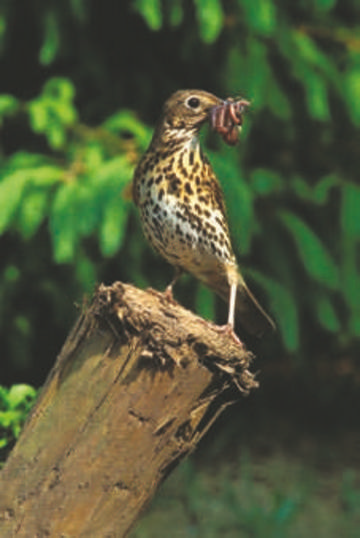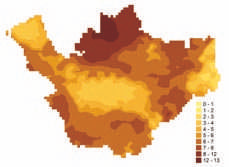
Song Thrush © John Power
Song Thrush numbers have declined greatly in the last forty years but it is still a relatively common bird and the population decline is not evident in its distribution within the county. The map shows that they were present in 639 tetrads, just eight fewer than in our First Atlas. Most of the tetrads without a Song Thrush probably result from under-recording, but there probably is some significance in their absence from four of the highest in the eastern hills, and perhaps from the gap of three tetrads in Frodsham Marsh and Weston Docks (SJ47Y to SJ48A). They have occasionally bred on Hilbre in the past, but not during either of our two Atlas periods (Craggs 1982).
Most of the confirmed breeding records came from observers seeing adults carrying a faecal sac or food (245 tetrads) or with recently-fledged young (130), with nests found (NE/ NY/ ON/ UN) in 86. Some birds can be easy to see with active nests, either feeding young or trying to drive away predators, especially cats, and evidence confirming breeding was found in 72% of tetrads, but others can be very secretive. They sing loudly, often from November onwards in some years, but many birds sing only briefly, before dawn, and are silent for most of the day (Snow 2003).
Farmland records contributed 31% (including 11% in hedges) and woodland 29%, with 6% in scrub, but the commonest category of habitat code submitted for this Atlas (33% of records) was ‘F’ - human sites. Gardens, allotments and farmsteads may well now be the most important sites in the county for Song Thrushes. In a breeding survey in ten tetrads in a mainly arable farming area of Essex (quoted by Snow 2003), gardens made up just 2% of the area but held 72% of the Song Thrush territories, and in another similar area there was a density of 25 pairs per km2 in villages and none in the surrounding farmland. The position in pastoral Cheshire is not as extreme, but it would be fascinating to perform a similar quantitative survey here.
The national population index was in free-fall from the early 1970s, dropping by one-quarter during the seven years of our First Atlas, but levelled out in the mid-1990s and has now risen again so that the 2004 figure is the same as that of 1984. The substantial decline led to Song Thrush being placed on the Red List of species of conservation concern, and national and local Biodiversity Action Plans written for it: so far, these have led to little action for its conservation but much research into the species’ ecology. This shows that the population decline was almost certainly driven by a fall in survival in the juveniles’ first winter, and perhaps also the post-fledging period, so that there are not enough recruits to replace adult mortality (Thomson et al 1997, Siriwardena et al 1998a, Robinson et al 2004). The environmental causes are not known, but changes in farming practices, land drainage, pesticides and predators are all candidates (Fuller et al. 1995, Robinson et al. 2004).

Song thrush abundance.
In Cheshire (without Wirral) the population fell by an average of more than 4% per annum from 1970 to 1986, halving the numbers in sixteen years, correlated with, and perhaps caused by, agricultural land drainage; drier soils substantially reduce the number of earthworms near to the surface, removing much of the thrushes’ staple diet (Peach et al. 2004). They then have to switch to spiders and snails, never as common in Cheshire’s sandy, calcium-deficient soils as in many other counties. The current breeding population of Cheshire and Wirral, from the BTO analysis of 2004-05 BBS data, is 17,200 birds (13,410-21,000), corresponding to an average of about 17 pairs per tetrad with confirmed or probable breeding, or 13 pairs per tetrad in which the species was recorded. This is only one-tenth of the county’s Blackbird population. Until about 1940, Song Thrushes outnumbered Blackbirds in Britain as a whole, and probably in Cheshire too.
Sponsored by Henry Finch

